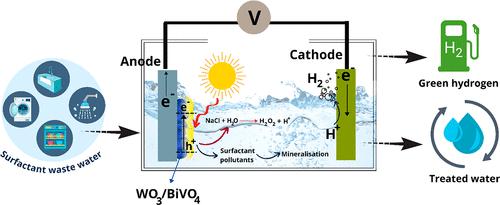当前位置:
X-MOL 学术
›
Ind. Eng. Chem. Res.
›
论文详情
Our official English website, www.x-mol.net, welcomes your feedback! (Note: you will need to create a separate account there.)
Photoelectrocatalytic Surfactant Pollutant Degradation and Simultaneous Green Hydrogen Generation
Industrial & Engineering Chemistry Research ( IF 4.2 ) Pub Date : 2023-06-02 , DOI: 10.1021/acs.iecr.3c00840 Katherine Rebecca Davies 1 , Michael G Allan 2 , Sanjay Nagarajan 3 , Rachel Townsend 4 , Vijayshankar Asokan 5 , Trystan Watson 1 , A Ruth Godfrey 4 , M Mercedes Maroto-Valer 6 , Moritz F Kuehnel 2, 7 , Sudhagar Pitchaimuthu 1, 6
Industrial & Engineering Chemistry Research ( IF 4.2 ) Pub Date : 2023-06-02 , DOI: 10.1021/acs.iecr.3c00840 Katherine Rebecca Davies 1 , Michael G Allan 2 , Sanjay Nagarajan 3 , Rachel Townsend 4 , Vijayshankar Asokan 5 , Trystan Watson 1 , A Ruth Godfrey 4 , M Mercedes Maroto-Valer 6 , Moritz F Kuehnel 2, 7 , Sudhagar Pitchaimuthu 1, 6
Affiliation

|
For the first time, we demonstrate a photoelectrocatalysis technique for simultaneous surfactant pollutant degradation and green hydrogen generation using mesoporous WO3/BiVO4 photoanode under simulated sunlight irradiation. The materials properties such as morphology, crystallite structure, chemical environment, optical absorbance, and bandgap energy of the WO3/BiVO4 films are examined and discussed. We have tested the anionic type (sodium 2-naphthalenesulfonate (S2NS)) and cationic type surfactants (benzyl alkyl dimethylammonium compounds (BAC-C12)) as model pollutants. A complete removal of S2NS and BAC-C12 surfactants at 60 and 90 min, respectively, by applying 1.75 V applied potential vs RHE to the circuit, under 1 sun was achieved. An interesting competitive phenomenon for photohole utilization was observed between surfactants and adsorbed water. This led to the formation of H2O2 from water alongside surfactant degradation (anode) and hydrogen evolution (cathode). No byproducts were observed after the direct photohole mediated degradation of surfactants, implying its advantage over other AOPs and biological processes. In the cathode compartment, 82.51 μmol/cm2 and 71.81 μmol/cm2 of hydrogen gas were generated during the BAC-C12 and S2NS surfactant degradation process, respectively, at 1.75 V RHE applied potential.
中文翻译:

光电催化表面活性剂污染物降解并同时产生绿色氢气
我们首次展示了在模拟太阳光照射下使用介孔WO 3 /BiVO 4光阳极同时降解表面活性剂污染物和产生绿色氢气的光电催化技术。对WO 3 /BiVO 4薄膜的形貌、微晶结构、化学环境、光吸收和带隙能等材料性能进行了检查和讨论。我们测试了阴离子型(2-萘磺酸钠(S2NS))和阳离子型表面活性剂(苄基烷基二甲基铵化合物(BAC-C12))作为模型污染物。通过在 1 个太阳下向电路施加 1.75 V 外加电势(相对于 RHE),分别在 60 分钟和 90 分钟内完全去除 S2NS 和 BAC-C12 表面活性剂。在表面活性剂和吸附水之间观察到光空穴利用的有趣竞争现象。这导致从水中形成 H 2 O 2以及表面活性剂降解(阳极)和析氢(阴极)。直接光孔介导的表面活性剂降解后没有观察到副产物,这意味着其相对于其他 AOP 和生物过程的优势。在阴极室中,在1.75 V RHE施加电势下,BAC-C12和S2NS表面活性剂降解过程中分别产生82.51 μmol/cm 2和71.81 μmol/cm 2的氢气。
更新日期:2023-06-02
中文翻译:

光电催化表面活性剂污染物降解并同时产生绿色氢气
我们首次展示了在模拟太阳光照射下使用介孔WO 3 /BiVO 4光阳极同时降解表面活性剂污染物和产生绿色氢气的光电催化技术。对WO 3 /BiVO 4薄膜的形貌、微晶结构、化学环境、光吸收和带隙能等材料性能进行了检查和讨论。我们测试了阴离子型(2-萘磺酸钠(S2NS))和阳离子型表面活性剂(苄基烷基二甲基铵化合物(BAC-C12))作为模型污染物。通过在 1 个太阳下向电路施加 1.75 V 外加电势(相对于 RHE),分别在 60 分钟和 90 分钟内完全去除 S2NS 和 BAC-C12 表面活性剂。在表面活性剂和吸附水之间观察到光空穴利用的有趣竞争现象。这导致从水中形成 H 2 O 2以及表面活性剂降解(阳极)和析氢(阴极)。直接光孔介导的表面活性剂降解后没有观察到副产物,这意味着其相对于其他 AOP 和生物过程的优势。在阴极室中,在1.75 V RHE施加电势下,BAC-C12和S2NS表面活性剂降解过程中分别产生82.51 μmol/cm 2和71.81 μmol/cm 2的氢气。



























 京公网安备 11010802027423号
京公网安备 11010802027423号